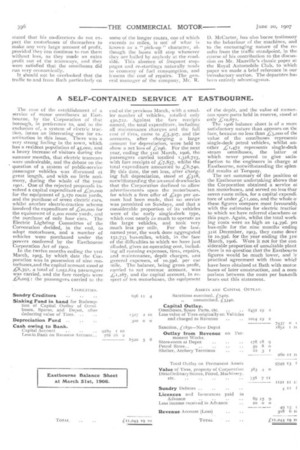A SELF-CONTAINED SERVICE AT EASTBOURNE.
Page 18

If you've noticed an error in this article please click here to report it so we can fix it.
The ease of the establishment of a service of motor omnibuses at Eastbourne, by the Corporation of that borough, in preference to, and to the exclusion of, a system of electric traction, forms an interesting one for examination in this issue. There was a very strong feeling in the town, which has a resident population of 45,000, and a heavy increase of visitors during the summer months, that electric tramcars were undesirable, and the debate on the question of a system of public-service passenger vehicles was discussed at great length, and with no little acrimony, during the whole of the year 1901. One of the rejected proposals involved a capital expenditure of L-30,000 for the equipment of 3,170 route yards, and the purchase of Seven electric cars, whilst another electric-traction scheme involved the expenditure of L72o,000 for the equipment of 2,200 route yards, and the purchase of only four cars. The Electric Lighting Committee of the Cornoration decided, in the end, to adopt motorbuses, and a number of vehicles were purchased under the powers conferred by the Eastbourne Corporation Act of 1902. In the twelve months ending the 1st March, 1905, by which date the Corporation was in possession of nine motorbuses,and the capital account stood at .4'8,391, a total of 1,052,624 passengers was carried, and the fare receipts were £6,005: the passengers carried to the end of the previous March, with a smaller number of vehicles, totalled only 430,722. Against the fare receipts named, the total expenditure, including all maintenance charges and the full cost of tires, came to L5,5o7, and the accounts, after charging a large amount for depreciation, were held to show a net loss of £296. For the next year, ending the 3 ist March, 1906, the passengers carried totalled 1,328,723, with fare receipts of L-7,857, whilst the total expenditure amounted to L'6,740. By this date, the net loss, after charging full depreciation, stood at L318, notwithstanding the unusual drawbacks that the Corporation declined to allow advertisements upon the motorbuses, for which a -firm offer of ..250 per annum had been made, that no service was permitted on Sundays, and that a considerable proportion of its vehicles were of the early single-deck type, which cost nearly as much to operate as the large vehicles, and took very much less per mile. For the lastnamed year, the work done aggregated 152,733 bus-miles, which, in the face of the difficulties to which we have just alluded, gives an operating cost, including all running expenses, tires, repairs, and maintenance, depot charges, aria general expenses, of io.59d. per car mile. The balance, being gross profit, carried to net revenue account, was j,;1,287, and the capital account, in respect of ten motorbuses, the equipment
of the dep6t, and the value of numerous spare parts held in reserve, stood at only L;10,671.
The 1906 balance sheet is of a more satisfactory nature than appears on the face, because no less than L'3,000 of the value of the omnibuses represents single-deck petrol vehicles, whilst another £1,472 represents single-deck steam omnibuses, the latter of which never proved to give satisfaction to the engineers in charge al Eastbourne, notwithstanding the splendid results at Torquay.
The net summary of the position 01 the Eastbourne undertaking shows that the Corporation obtained a service 01 ten motorbuses, and served no less thar seven route miles, for a capital expendi. -lure of under L-ii,ocio, and the whole o. these figures compare most favourabl) with the estimates for electric tractior to which we have referred elsewhere or this page. Again, whilst the total work. ingcosts were as high as 14.39d. pei bus-mile for the nine months ending 3ist December, 1903, they came dowr to ro.59d. for the year ending the 3 Is' March, 1906. Were it not for the con. siderable proportion of unsuitable plant there is no question that the Eastbourm figures would be much lower, and ir practical agreement with those whicl have been obtained at Bath with motor. buses of later construction, and a coin parison between the costs per bus-mil( bears out this statement.






























